Handgun Grips: The Ultimate Guide
 Bryan Hill / March 21 2024
Bryan Hill / March 21 2024
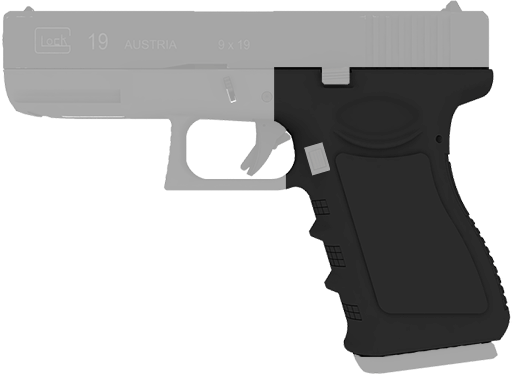
A pistol's grip is the part you hold when aiming and firing it.
It contains the
magazineand
mag release.
We're going to cover how a pistol's grip can affect your ability to shoot fast and accurately, whether you should upgrade your grip, and which pistol has the best grip.
On This Page:
- Why Does a Good Grip Matter?
- What Makes a Good Grip?
- Grip Angle
- Should I Upgrade My Grip?
- Which Pistol Has the Best Grip?
- Grip Technique
- References
Why Does a Good Grip Matter?
A good grip helps with
grip technique, which has the most impact on controlling
recoil.
If a grip isn't fitted for your hand, it's harder to pull the
trigger.
That can spoil your aim.
Want to fire faster and more accurately? Choose a pistol with the right grip for you.
What Makes a Good Grip?
-
Long enough to fit your hand.
If you can't get all your fingers on the grip, you'll have much worse recoil control.
If a grip is too short, look into extended magazines:
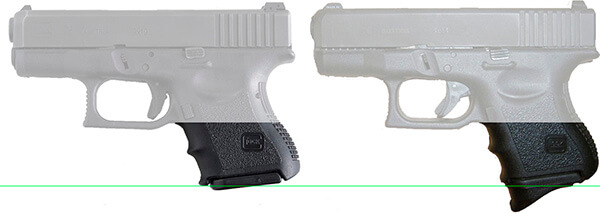
-
(Concealed carry) short enough to conceal.
Compact pistols: the grip prints the most,so look for grips just long enough to fit your hand.
Pocket pistols: small enough to fit in your pants/jacket/dress pockets.
-
Good Trigger Reach. The grip should make it so that it's easy to get your first finger joint on the trigger.
If the grip makes it so you can only get the tip of your finger on, it will be much harder to press the trigger straight back.
-
Enough grip for your support hand to contact it.
If the grip is too small, your support hand will only contact your shooting hand's fingertips, and it won't contribute much to recoil control.
-
Adjustments, for better recoil control. Everyone's hands are different. The grip should have adjustable backstraps, side panels, or both to change grip thickness:
-
Side panels can be changed on most steel-frame pistols.
If they go all the way up to the level of the trigger, like on the CZ Shadow 2 below, they can affect trigger reach as well as grip size.
If a side panel has "palm swell", it's designed to increase grip size while having a minimal effect on trigger reach, if any.
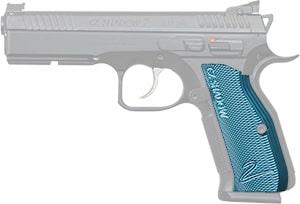
Changing side panels to make the grip thicker aren't as good for concealed carry, as the grip is what prints.
-
Backstraps can be changed on most polymer-framed pistols. They sometimes affect trigger reach as well as grip size.
If the backstrap replacement goes up all the way up to the level of the trigger, watch out. The backstrap on this CZ P-10c, below, does not affect trigger reach.
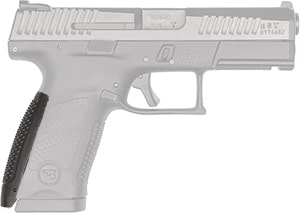
Changing backstraps to make the grip bigger are best for concealed carry, as they generally do not increase the overall height of the gun or the width of the grip.
Everyone's hands are different. If there's a part of the grip
that doesn't fit your hand, you can either customize the grip to fit,
or choose a better-fitting pistol.
-
For smaller grips, aftermarket overgrips.
Overgrips wrap around the grip to make it fit larger hands. An example on the right:
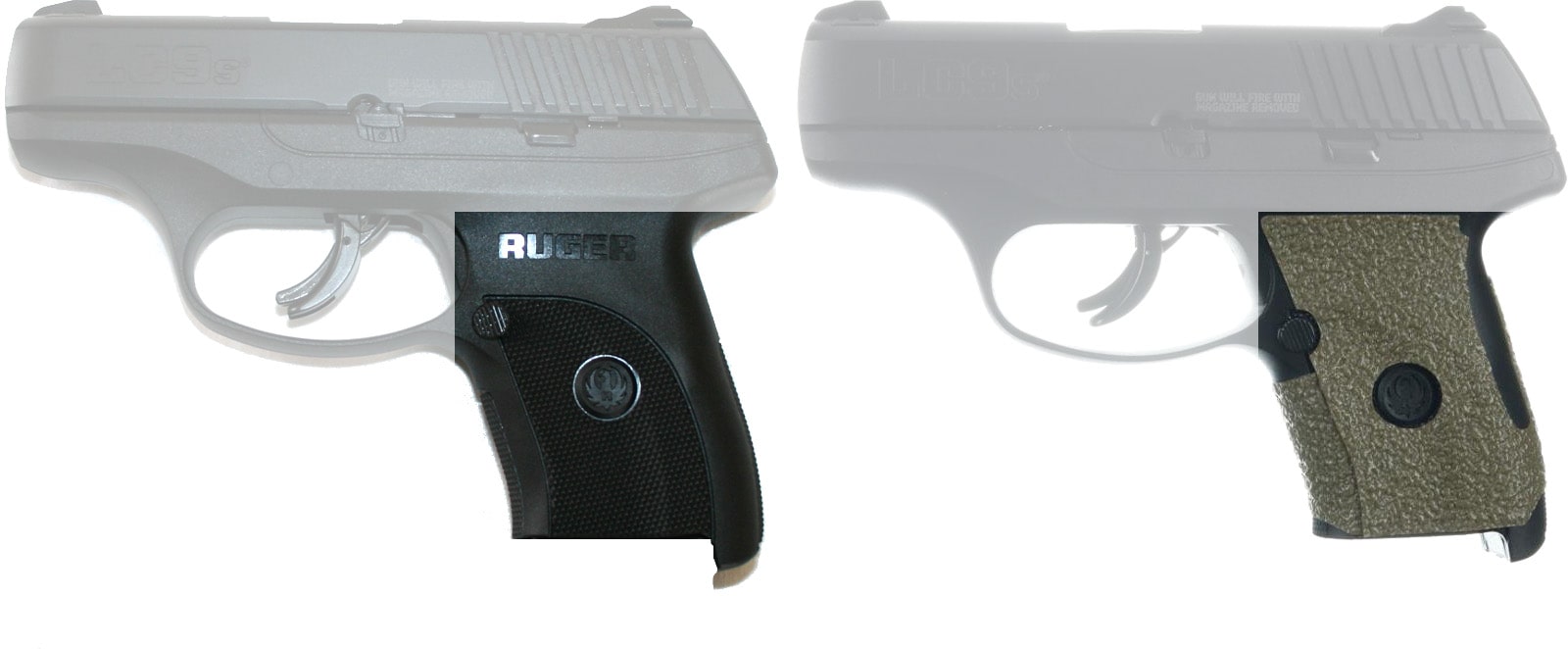
-
A good magwell, for fast and easy reloads.
-
For a home defense or competition pistol, a flared magwell is best.
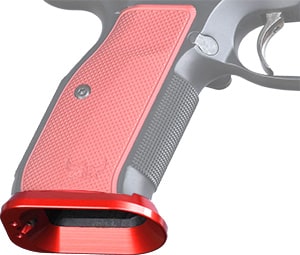
-
For concealed carry, an internal magwell is best. The insides are beveled to help funnel in the magazine, without adding extra bulk to the grip.
-
Texturing for better grip. It should be on he back, front, and sides.
-
Skateboard tape is best for competition and home defense.
It has the best grip, but is so rough that it tears up clothes when concealed carrying.
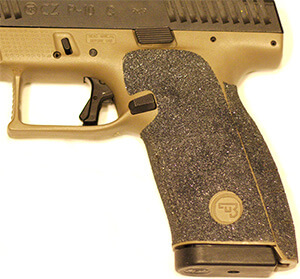
-
Checkered texture is great for carry.
It's as grippy as it can be without tearing up clothes.
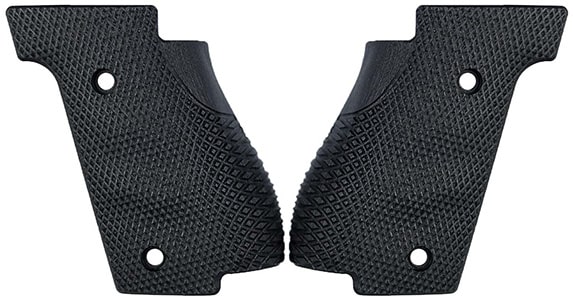
-
Proprietary textures vary.
Try and compare with the other two types and judge for yourself.
The texture usually fits the purpose of the pistol.
Compact / pocket pistols: softer texture to not tear up clothing.
Full-size pistols: rougher texture if made for competition.
-
Grip angle points naturally. Here's a test: take your gun, get a good grip on it in a high compressed ready position.
Close your eyes. Press out to full extension. Open your eyes; see if the sightsare level.
You may need to raise the gun a bit to get the sights to eye level.
If the front sight is higher or lower than the rear sight, then the grip angle isn't good for you.
Changing the backstraps might help. Otherwise, put in extra dry practice or choose a gun with a different grip.
Grip Angle
The angle from the grip to the slide affects its
natural point of aim.
Pistols with shallow angles, like a Sig p320 (16º) point lower. Glocks have steeper angles (21º) and point higher:

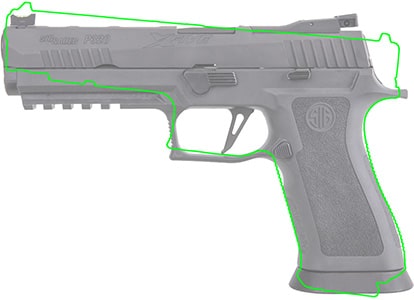
What's right for you? Here's a test:
-
Set up a target in a safe area (even if you shot it, the bullets wouldn't go through and hit someone or something important).
-
Unload your pistol.
-
Present your gun at the target as though you were going to shoot it. Get a good sight picture.
-
Lower the gun (or holster it, if you have one).
-
Close your eyes. Present the gun again at your target.
-
Open your eyes. Are your sights on target?
If they're too high, the grip angle may be too steep.
If they're too low, the grip angle may be too shallow.
-
Repeat this at least 5 times to be sure you get consistent results.
The more skilled you become, the less a pistol's grip angle matters. But if one pistol takes 500 reps to point perfectly, and another takes 1000 reps because of the grip angle, that could be a factor in which pistol is right for you.
Also, if all your pistols have about the same grip angle, you won't have to adjust your aim when switching pistols.
Glocks are made to all have the same grip angle and controls, so it's easy to go from a pocket pistol to a full-size with Glocks.
On the other hand, the Glock grip angle so steep that people find they have to crane their wrist to see the sights.
Craning the wrist decreases your effective grip strength and some people have reported getting repetitive stress injuries
from putting in several hours of practice per week with Glocks, but not pistols with more shallow grip angles.
Do you have the time and motivation for more training and practice? That's up to you.
Should I Upgrade My Grip?
Which Pistol Has the Best Grip?
The
H&K VP9 is the only pistol that comes with adjustable side panels
and backstraps. If you have trouble finding a pistol that fits your hands, try the VP9.
Best Deal Guarantee
Updated hourly
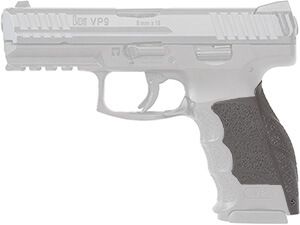
H&K VP9
Compare Prices
|
Grip Technique
Even with a perfectly-fit grip, you still need to know how to grip a pistol
to manage recoil.
Learn How to Grip a Pistol The Right Way
Related Articles
Feedback
Are you happy with this page?
References
-
Effect of static wrist position on grip strength (2019)
-
22 degree grip angle of the glock and 18 degree Non-OEM frames (2019)
-
Grip Angle (2017)
-
THE INFLUENCE OF FOREARM AND WRIST ORIENTATION ON STATIC GRIP
STRENGTH AS A DESIGN CRITERION FOR HAND TOOLS (2016)
-
What grip angle is best? (2014)
-
Comparison of grip strength among 6 grip methods (2014)
-
Practical Demonstrations of Ergonomic Principles (2011)
-
Todd Jarrett: Natural point of aim (2011)
-
The relationship between wrist position, grasp size, and grip strength (1992)